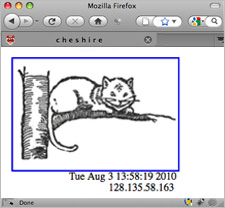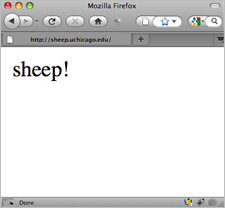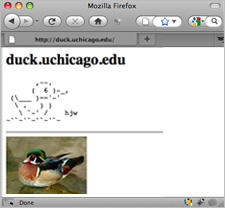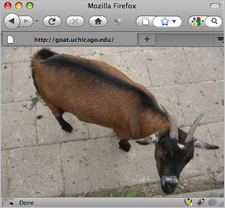| Sun | Mon | Tue | Wed | Thu | Fri | Sat |
|---|---|---|---|---|---|---|
| 1 | 2 | 3 | 4 | 5 | ||
| 6 | 7 | 8 | 9 | 10 | 11 | 12 |
| 13 | 14 | 15 | 16 | 17 | 18 | 19 |
| 20 | 21 | 22 | 23 | 24 | 25 | 26 |
| 27 | 28 | 29 | 30 | 31 |
CATEGORIES
RECENT ENTRIES
BLOG ROLL
Does the flap of a tweet’s wings set off a tornado in Chicago?
When an intern discovers a strange URL on the University network, his curiosity leads him down the rabbit hole.
Last week a typical, terse little tweet twinkled out into the world. Tagged #UChicago, the tweet did but one thing: recommend, with a "lol," that its reader direct his web browser toward goat.uchicago.edu. Humble and unsuspecting intern Asher Klein, '11, saw the tweet and, using a trick he'd learned in his pre-intern days, typed "goat" into his University-networked computer, which he knew would bring him to the same page. He hit enter, and nothing was ever again the same.
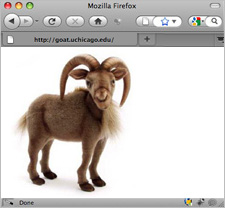
This picture was all that showed up on the page advertised by the (this week conveniently, perhaps mysteriously, unavailable) tweet. What was this strange picture doing on this random URL? our intern thought. What, or who, is this goat, and what could it possibly want with the University of Chicago?
Fighting his mystery-solving instincts, our intern put it out of his mind for the time being, to do other things, things involving real work at the Magazine that he soon accomplished with his trademark brand of humility and being unsuspecting (see above epigram). But soon another digital discovery shook him to his core, all the result of an errant keystroke.
Go to d.uchicago.edu, or, as our intern did, simply type "d" as the URL on a University computer, and you will find this image:
On the website, the Cheshire Cat image links to an e-text of Alice's Adventures in Wonderland. "What?" our intern may or may not have exclaimed when he came upon the page. "What madness is this?" His whole world spinning, the intern suddenly saw the scope of the situation.
Frantically, he began to type, and the plot, as plots are wont to do, thickened. "Cat" got him a page load error, but, the error message said the site seemed valid. The same message loaded for "Whale," "Bear," and "Owl." But typing "Horse," "Bull," or "Robin" got an NSIT page: "URL Reserved," they said, suggesting those with questions e-mail a listhost. "Dog" was a failed connection that referenced elk.uchicago.edu, but "Elk" failed too!
The animal searching continued, and new discoveries were made: some pages were under construction, others forbidden, still more just timed out. "Lobster" references the Office of Student Aid. "Tuna" brings up only the text "Diderot.uchicago.edu;" "Diderot" the same! The University network was looping in on itself, a Mobius strip of terror the likes of which mystery blog posts had never before seen.
Then, perhaps most dreadful of all, the intern's search for "Sheep" called up a one-word response:
When he came to, the intern realized he needed help. He called Sara Worrell-Berg, director of web services at the University, who explained that "Goat" is the name of a development server, and, like all campus servers, it has a virtual host name as well as a number, which is easier for its keepers to remember. She said the programmers "might place an image on there," but that the goat image "should probably just be taken down."
Relieved, our intern made one more phone call, to Lead Web Systems Administrator Paul Barton. He confirmed that some servers are named after animals—the ones that host the Magazine are "Rhino," "Koala," "Wallaby," and "Kangaroo"—but there was only so much he could say. "There are thousands of servers on campus, and our group is only responsible for 200, 300 of them." He did offer that the goat was in his group's domain and was being taken down.
It was a mystery no more, but there was more searching to be done. The intern saw that "Duck" was more charming than terrible:
And, in fact, animals weren't the only server names; mythological figures (Zeus, Anubis, Loki, Chimera), things in space (Star, Nova, black hole), and German names (Otto, Simon, Marx, even Klein) all stood for servers.
With things seemingly back on track, the intern was humbly ready to return to his work and innervated with new trivia about the University's servers. But a thought buzzing around gave him pause. Was the goat really gone? It was surely just an image, he told himself. Pay it no mind. The truth is that you're just a paranoid intern who doesn't want to finish fact-checking his article. He laughed, but it rang hollow in his cubicle. He made one last foray into the server's domain.
The old goat was gone, but in its place was an even more horrible goat, its one terrible coin-slot eye a metal stake boring into the intern's very soul!
Asher Klein, '11
August 3, 2010

